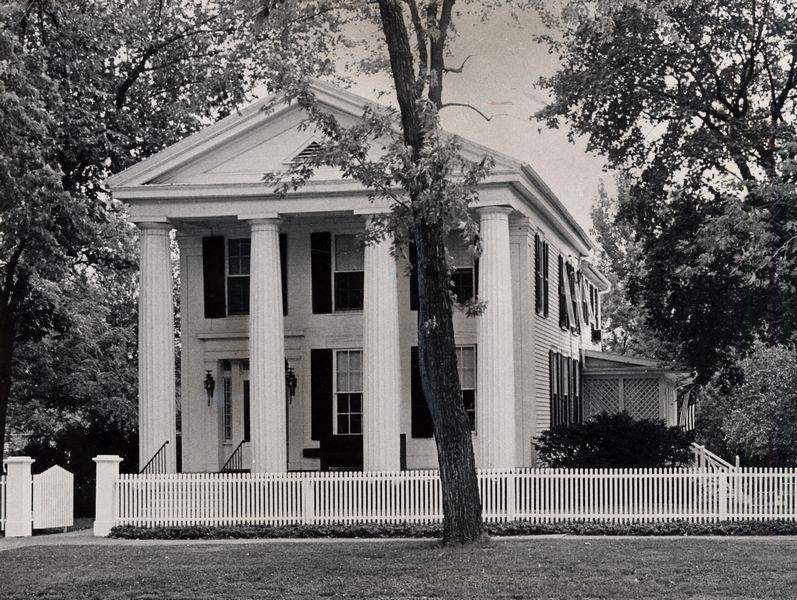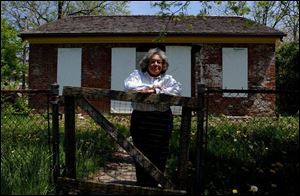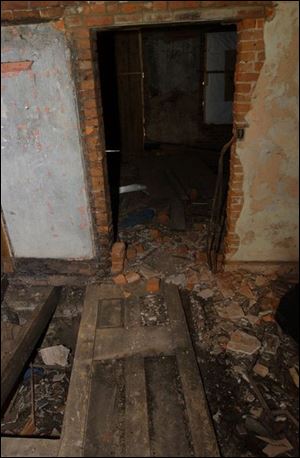
Homes on slaves' trips to freedom face neglect
5/16/2004
The Four Pillars house in Maumee was a stop along the Underground Railroad. Slaves hid in the basement until they were able to escale onto canal boats to Canada.

Betty Grimes is leading an effort to save the Gammon House in Springfield, Ohio.
Beverly Gray is happy to take people around Chillicothe, Ohio, and show them where escaped slaves hid on their way north to freedom in the 1800s.
She calls it the parking lot tour.
"So many of those places have been torn down," she said. "We try to save them, but unfortunately that doesn't happen very often."
Ohio is rich in Underground Railroad history. More than 600 sites have been identified that were at one point part of the system that helped slaves who escaped from the South and found refuge in northern Ohio, Michigan, and Canada.

The basement of the Gammon House in Springfield, Ohio, was used by escaped slaves.
But more than 150 of those places have been demolished, and preservationists say the state is likely to lose many more as the buildings age and developers eye the land for new homes and businesses.
So they dug in their heels and started working to save the homes that are left. Many are abandoned property already owned by someone who has visions of better houses, schools, or businesses. Around the state, residents and historical societies have pleaded with owners to save the sites. Often they end up buying the houses themselves.
But with no state or federal money to help them, these groups acknowledge this might be a losing battle.
"We have the sense to know we'll probably lose more than we save," said Ms. Gray, vice president of the Ohio Underground Railroad Association. "Many times we're dealing with corporations that have far more

The Four Pillars house in Maumee was a stop along the Underground Railroad. Slaves hid in the basement until they were able to escale onto canal boats to Canada.
money than we do."
The face of that fight in northwest Ohio is the Lathrop House, owned by the Roman Catholic Diocese of Toledo and reported to be a stop on the Underground Railroad. Some community members wanted the house saved; the church wanted to raze the old home to make way for an addition to St. Joseph School.
The battle led to protests, a threat by the city of Sylvania to take the property by eminent domain, and a referendum where voters sided with the church.
Last week, a contractor hired by the church raised the Lathrop House off its foundation and moved it a short distance, a move preservationists had been fighting.
Preservationists argued it was the site that was important because the basement of the house off a ravine was used by slaves to get to the house.
When the Lathrop House was moved, portions of the basement's walls collapsed. But the walls were photographed before the move, and the stones from the walls were placed in storage.
Sylvania officials say the house will be moved nearby to a site on the ravine in the city's Harroun Park and eventually be operated by Toledo Area Metroparks as an historic site.
Relocating historic homes is something preservation groups around the state have fought.
"It was the ground, the area, the spot that's important," Ms. Gray said. "You try to save a spot where an important part of history took place."
Steve Gordon, survey and national register manager with the Ohio Historic Preservation Office, said he sympathizes with the groups trying to save these important homes. Funding is hard to come by in tough economic times. Without documentation to prove the site was part of the Underground Railroad, the home can't be protected on the national historic registry and it would be hard to convince owners to save it.
But preserving the sites is important, he said.
"The African American experience and the Underground Railroad in Ohio is an important story to tell," he said. "I think it's more compelling when people can actually see the sites. The real place is gong to have more of an emotions impact than a document or a museum."
In 1847, freed slave Nelson T. Grant bought a house in Zanesville and used it to help other slaves in need of food, clothes, and encouragement.
When Connie Quarles found out about the home a few years ago, it was a tavern that the bank had foreclosed on, and it was sitting empty for three years. Two people had put in offers to buy the property.
Community members formed the Nelson T. Gant Foundation and asked the bank to sell the house to them. The bank said if the group could raise $70,000 in a year, it would forgive another $20,000 of the cost.
The group set out seeking donations. The Longaberger Co. gave $10,000. A local foundation gave $15,000, and 12 people donated at least $1,000 each.
"We raised that money three weeks early," Ms. Quarles said. "We had a little mortgage burning."
But buying the house was the cheap part. Fixing the dilapidated home and restoring it to its original look, which involves hiring historians and architects, will cost more than $200,000. Right now the group is trying to prevent further damage, but over the winter water pipes broke and the roof leaked.
"At least it's paid off," Ms. Quarles said. When the renovation is complete, the group hopes to turn the home into a cultural center to recognize African-Americans who were important to the community.
The Underground Railroad Association formed 10 years ago and started to document sites that were part of the system - including the Lathrop House - and lists three houses that have been saved.
"Unfortunately, usually by the time we realize the site is part of the Underground Railroad, it's being torn down," Ms. Gray said.
Some are owned by senior citizens who cannot afford the upkeep, let alone restoration. One house in Mt. Pleasant that the state group said was part of the Underground Railroad showed up on Ebay when the owner wanted to sell it. Many of the houses are abandoned, and the city or landowner is preparing to tear them down.
The city of Springfield was preparing to tear down the house owned by George Gammon, an African-American who helped escaped slaves, when a community member bought it. That man willed the house to a friend, who asked for help and money from a neighborhood group called South Fountain Preservation Inc.
The group hopes to raise $500,000 to restore the tiny home where Mr. Gammon and his wife, Sarah, raised their children, according to organizer Betty Grimes. Right now they're concentrating on raising money for a new roof; tarps protect the house from more water damage.
"The wrecking ball was on its way. The city was going to demolish it, but we wanted it saved," she said. "If someone owns the property and you go to them and say, 'This is a stop on the Underground Railroad,' they don't think it's too significant. There's been roads of highway that have gone through the sites. Now they can just say, 'There used to be a house here that was part of the Underground Railroad.'●"
In northwest Ohio, Genevieve Eicher has dreams of restoring the church in Ridgeville Corners where slaves hid in the basement. The First Congregational Church in Henry County was deeded to Mrs. Eicher and her husband by the last members of the congregation. It's empty now, but the Eichers have spent money to keep it from deteriorating.
Historical groups and preservationists around the state are eyeing old Underground Railroad sites and dreaming of saving and restoring them. They just cannot usually afford it, Ms. Gray said.
One prominent site on the railroad still stands tall in Maumee - the "House of the Four Pillars" at 322 East Broadway. Built about 1836, slaves escaping to freedom hid and rested in the basement of the house until it was time to flee Canada. They would leave the basement following a gully behind the house to the Miami and Erie Canal and then by boat to safety. It is said that the old basement door was left unlocked day and night.
State officials say they want to preserve Ohio's Underground Railroad history. The state maintains several sites, including the Rankin House in Ripley, Ohio, once owned by John Rankin, who was a minister and devoted much of his life to helping slaves. The house is now a museum.
The Ohio Historical Society has collections of photos and other memorabilia. The Underground Railroad Freedom Center, a national museum, is set to open in Cincinnati in August.
But there is no state or federal money available to help save these sites.
That's not likely to change anytime soon because of state and federal budget woes that led to cuts in nearly every department, said Steve Gordon, survey and national register manager at the Ohio Historic Preservation Office.
"We don't have funding. That's probably the biggest limitation we have. Every state and municipal budget is strained. We can't authorize new programs," he said. "That's a reflection of the economic times right now."
That leaves community groups or owners of these homes struggling to find money on their own.
"Many are owned by senior citizens that are on fixed income and can't afford it. Many are abandoned," he said. "The question is who is responsible for fixing that up."
The Ohio Historic Preservation Office does help these groups try to get homes on the national registry of historic places. That makes it hard for developers to demolish the historic buildings. Their efforts have been successful in several cases, including the John P. Parker house in Ripley.
The process is rigorous. The national program requires documentation to make sure the house was not just home to an abolitionist but was used as part of the Underground Railroad.
That takes years to prove, and sometimes it's not possible. Historians sift through newspaper articles, government records, and other documents but the whole idea of the Underground Railroad was to be secretive. Sometimes the documentation does not exist.
That's been the situation in Lenawee County, home to well- known abolitionist Laura Haviland, who openly helped slaves to freedom.
"You're talking about houses that were 150 years old. There aren't many left," said Adrian historian Charles Lindquist. "And you need documentation. By the time you get through that, you don't have much."
Mr. Lindquist said he does not know of any houses in the Lenawee County area that were restored because they were part of the Underground Railroad.
Ms. Gray of the Ohio Underground Railroad Association said educating communities about the history of the homes may be the key to saving them, but said time is not on preservationists' side. In the years it takes to save a house, several more are demolished.
"About the only thing that can be done is to make the people aware of the situation in an effort to bring the spotlight and to try to discourage the person to tear it down," she said. "Sometimes you have to wonder if it's doing any good."